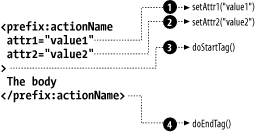Developing a Simple Action
As you have seen in the previous chapters, a custom action element in a JSP page consists of a start tag (possibly with attributes), a body, and an end tag:
<prefix:actionName attr1="value1" attr2="value2"> The body </prefix:actionName>
If the action element doesn’t have a body, the following shorthand notation can be used instead:
<prefix:actionName attr1="value1" attr2="value2" />
A Java class referred to as a tag handler implements the
action’s behavior. In order for the tag handler to
do anything interesting, it needs access to the request and scope
information, as well as the action element’s
attribute values (if any). The container calls methods defined in the
Tag interfaces to provide it with this
information. For the attribute values, the JSP container treats the
tag handler as a bean and calls a property setter method
corresponding to each attribute. The Tag interface
also contains methods called by the container when the start tag and
end tag are encountered, as shown in Figure 20-2.

Figure 20-2. Tag interface methods and property setter methods
A tag handler that implements just the Tag
interface can add dynamic content to the response body and set
response headers, add or remove variables in one of the JSP scopes,
and tell the container to either include the action
element’s body in the response or ignore it.
Here are the most important methods ...
Get JavaServer Pages, Second Edition now with the O’Reilly learning platform.
O’Reilly members experience books, live events, courses curated by job role, and more from O’Reilly and nearly 200 top publishers.

